Research on Improved BBO Algorithm and Its Application in Optimal Scheduling of Micro-Grid
Abstract
:1. Introduction
2. Microgrid System and Optimal Scheduling Models
2.1. Microgrids Integrating CCS and P2G
2.2. Optimal Scheduling Models for Microgrid Systems
2.2.1. Scheduling Model Based on the Lowest Cost of System Operation
- The energy interaction cost can be expressed aswhere represents the interactive power between the microgrid and the large power grid; represents the interactive unit price.
- The carbon treatment cost can be calculated withwhere represents the power consumption coefficient of CO2 capture, ; represents the total amount of CO2 captured; represents the fixed power consumption factor, ; represents output power; represents the unit price of power output.
- The operating cost is expressed as followswhere , , , , , and represent the operating costs of WT, PV, MT, DE, P2G, and BESS, respectively.
- 4.
- The revenue from the purchase-sale of electricity is expressed aswhere represents the unit price of electricity sold to the large grid; represents the electrical load power.
2.2.2. Scheduling Model Based on Environmental Governance Cost Minimization
2.2.3. Scheduling Model Based on Comprehensive Economic Efficiency Optimization
2.3. Energy Control Strategies for Microgrid System
3. IBBO Algorithm
3.1. Cosine Mobility Model
3.2. Search Process
3.3. Ecological Expansion Operation
3.4. Convergence Analysis
4. Simulations and Discussion
4.1. IBBO Performance Analysis
- Initialization parameters
- 2.
- Migration
- 3.
- Mutation
- 4.
- Elite preservation operation
4.2. Optimal Scheduling Considering System Operating Costs
4.3. Optimal Scheduling Considering Environmental Governance Costs
4.4. Optimal Scheduling Considering Comprehensive Economic Benefits
5. Conclusions
Author Contributions
Funding
Institutional Review Board Statement
Informed Consent Statement
Data Availability Statement
Conflicts of Interest
References
- Liu, C.; Wang, H.; Li, T.; Jin, X.; Li, Z. Study on influence of distributed new energy generation on distribution network voltage. Renew. Energy Resour. 2019, 37, 1465–1471. [Google Scholar]
- Song, X.; Han, L.; Ju, H.; Chen, W.; Peng, Z.; Huang, F. A review on development practice of smart grid technology in China. Electr. Power Constr. 2016, 37, 1–11. [Google Scholar]
- Guo, P.; Liu, W.; Dan, Y.; Li, Y.; Liang, C. Reactive Power Coordinated Control to Reduce Grid Loss with Large-scale Wind Power Integration. J. Syst. Simul. 2017, 29, 190–199. [Google Scholar]
- Sun, W.; Liu, T.; Liu, B.; Wang, Y. Network Mode and Economy Analysis of Photovoltaic-Battery System in Microgrid. J. Syst. Simul. 2018, 30, 1812–1818. [Google Scholar]
- Qian, F.; Pi, J.; Liu, J.L.; Fu, C.; Song, J.H.; Zhang, X.J.; Wen, W.; Fan, Y.P. Review of microgrid modeling and control theory. Eng. J. Wuhan Univ. 2020, 53, 1044–1054. [Google Scholar]
- Wang, Y.; Li, F.; Yu, H.; Wang, Y.; Qi, C.; Yang, J.; Song, F. Optimal operation of microgrid with multi-energy complementary based on moth flame optimization algorithm. Energy Sources Part A Recovery Util. Environ. Eff. 2020, 42, 785–806. [Google Scholar] [CrossRef]
- Liu, C.; Zhang, H.; Shahidehpour, M.; Zhou, Q.; Ding, T. A Two-Layer Model for Microgrid Real-Time Scheduling Using Approximate Future Cost Function. IEEE Trans. Power Syst. 2022, 37, 1264–1273. [Google Scholar] [CrossRef]
- Zhang, M.; Chen, J.; Yang, Z.; Peng, K.; Zhao, Y.; Zhang, X. Stochastic day-ahead scheduling of irrigation system integrated agricultural microgrid with pumped storage and uncertain wind power. Energy 2021, 237, 121638. [Google Scholar] [CrossRef]
- Tostado-Véliz, M.; Kamel, S.; Hasanien, H.M.; Turky, R.A.; Jurado, F. A mixed-integer-linear-logical programming interval-based model for optimal scheduling of isolated microgrids with green hydrogen-based storage considering demand response. J. Energy Storage 2022, 48, 104028. [Google Scholar] [CrossRef]
- Cao, B.; Dong, W.; Lv, Z.; Gu, Y.; Singh, S.; Kumar, P. Hybrid Microgrid Many-Objective Sizing Optimization with Fuzzy Decision. IEEE Trans. Fuzzy Syst. 2020, 28, 2702–2710. [Google Scholar] [CrossRef]
- Ali, L.; Muyeen, S.M.; Bizhani, H.; Ghosh, A. A multi-objective optimization for planning of networked microgrid using a game theory for peer-to-peer energy trading scheme. IET Gener. Transm. Distrib. 2021, 15, 3423–3434. [Google Scholar] [CrossRef]
- Yu, J.; Sun, C.; Kong, R.; Zhao, Z. Multi-objective optimization configuration of wind-solar-storage microgrid based on NSGA-III. J. Phys. Conf. Ser. 2021, 2005, 012149. [Google Scholar] [CrossRef]
- Shan, J.; Lu, R. Multi-objective economic optimization scheduling of CCHP micro-grid based on improved bee colony algorithm considering the selection of hybrid energy storage system. Energy Rep. 2021, 7, 326–341. [Google Scholar] [CrossRef]
- Yang, Y.; Qiu, J.; Qin, Z. Multidimensional firefly algorithm for solving day-ahead scheduling optimization in microgrid. J. Electr. Eng. Technol. 2021, 16, 1755–1768. [Google Scholar] [CrossRef]
- Dai, X.; Lu, K.; Song, D.; Zhu, Z.; Zhang, Y. Optimal economic dispatch of microgrid based on chaos map adaptive annealing particle swarm optimization algorithm. J. Phys. Conf. Ser. 2021, 1871, 012004. [Google Scholar] [CrossRef]
- Zhang, Q.S. Research on Grid Connected Optimization Scheduling of Micro-Grid Utilizing on Improved Bee Colony Method. Distrib. Gener. Altern. Energy J. 2022, 37, 23–40. [Google Scholar] [CrossRef]
- Kumari, K.S.K.; Babu, R.S.R. An efficient modified dragonfly algorithm and whale optimization approach for optimal scheduling of microgrid with islanding constraints. Trans. Inst. Meas. Control. 2021, 43, 421–433. [Google Scholar] [CrossRef]
- Chen, J.; Wang, C.; Zhao, B.; Zhang, X. Economic operation optimization of a stand-alone microgrid system considering characteristics of energy storage system. Autom. Electr. Power Syst. 2012, 36, 25–31. [Google Scholar]
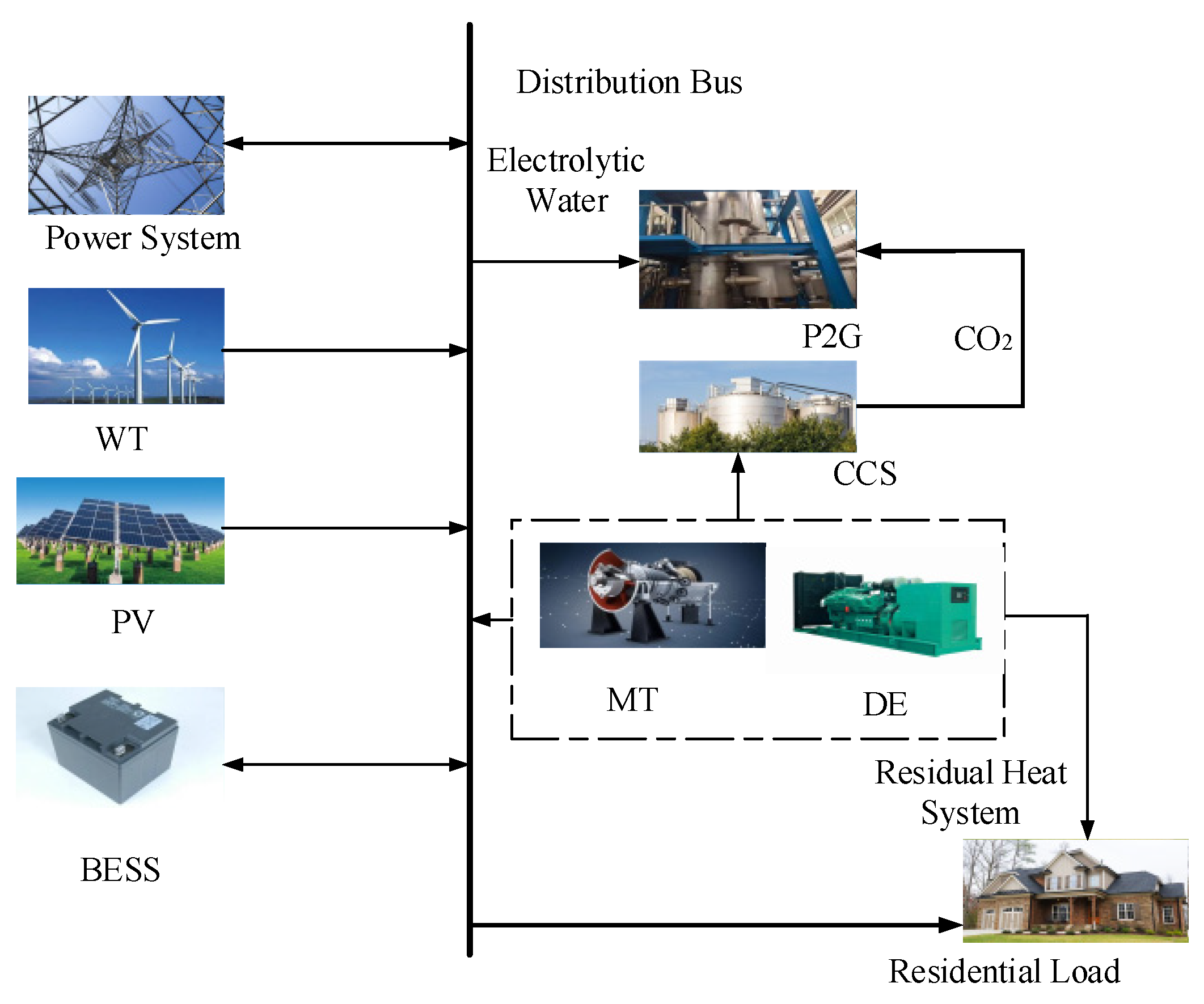

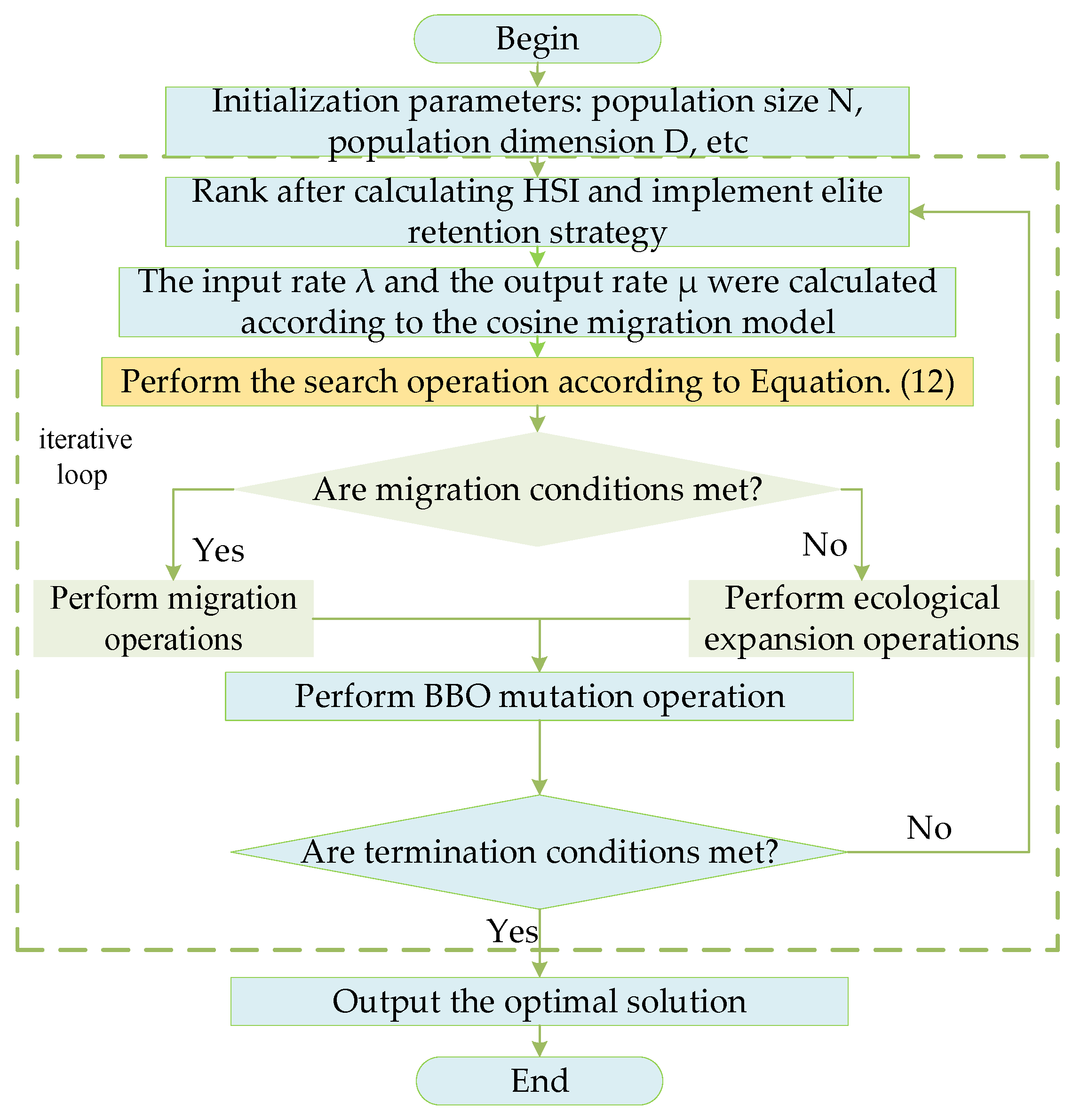
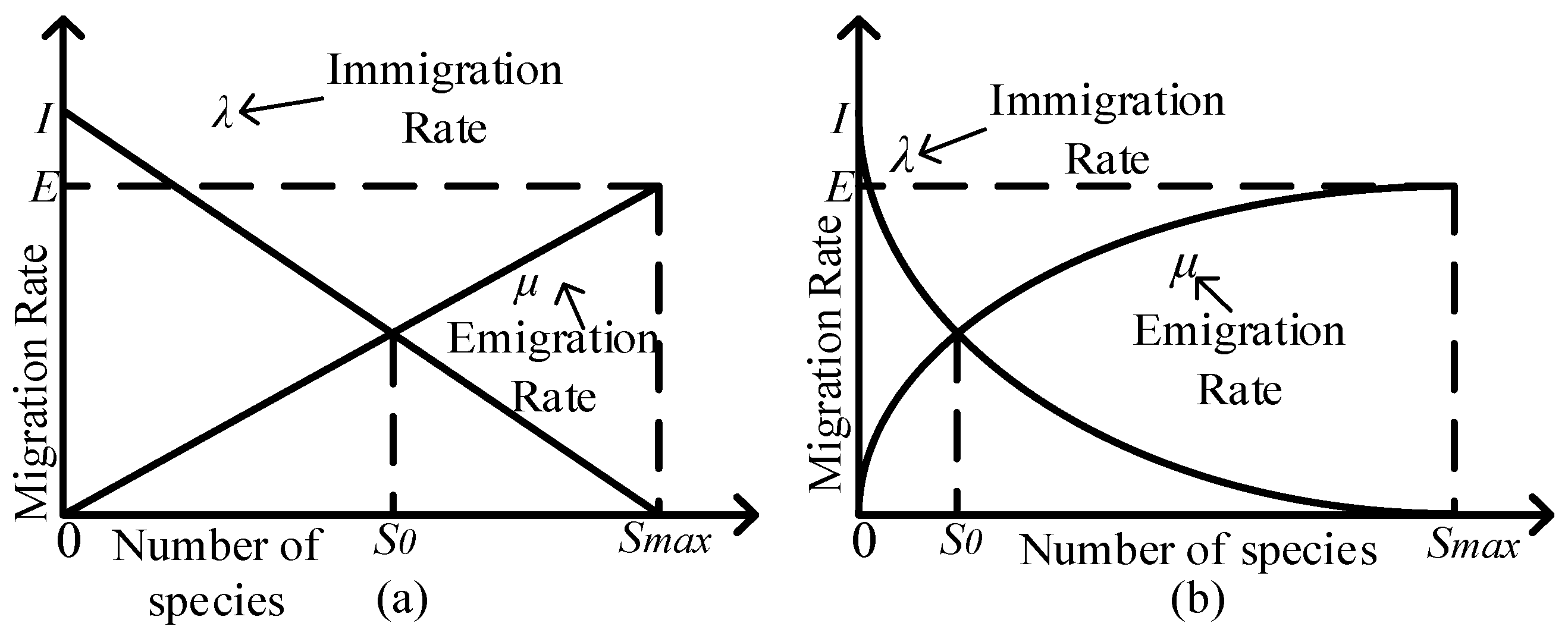
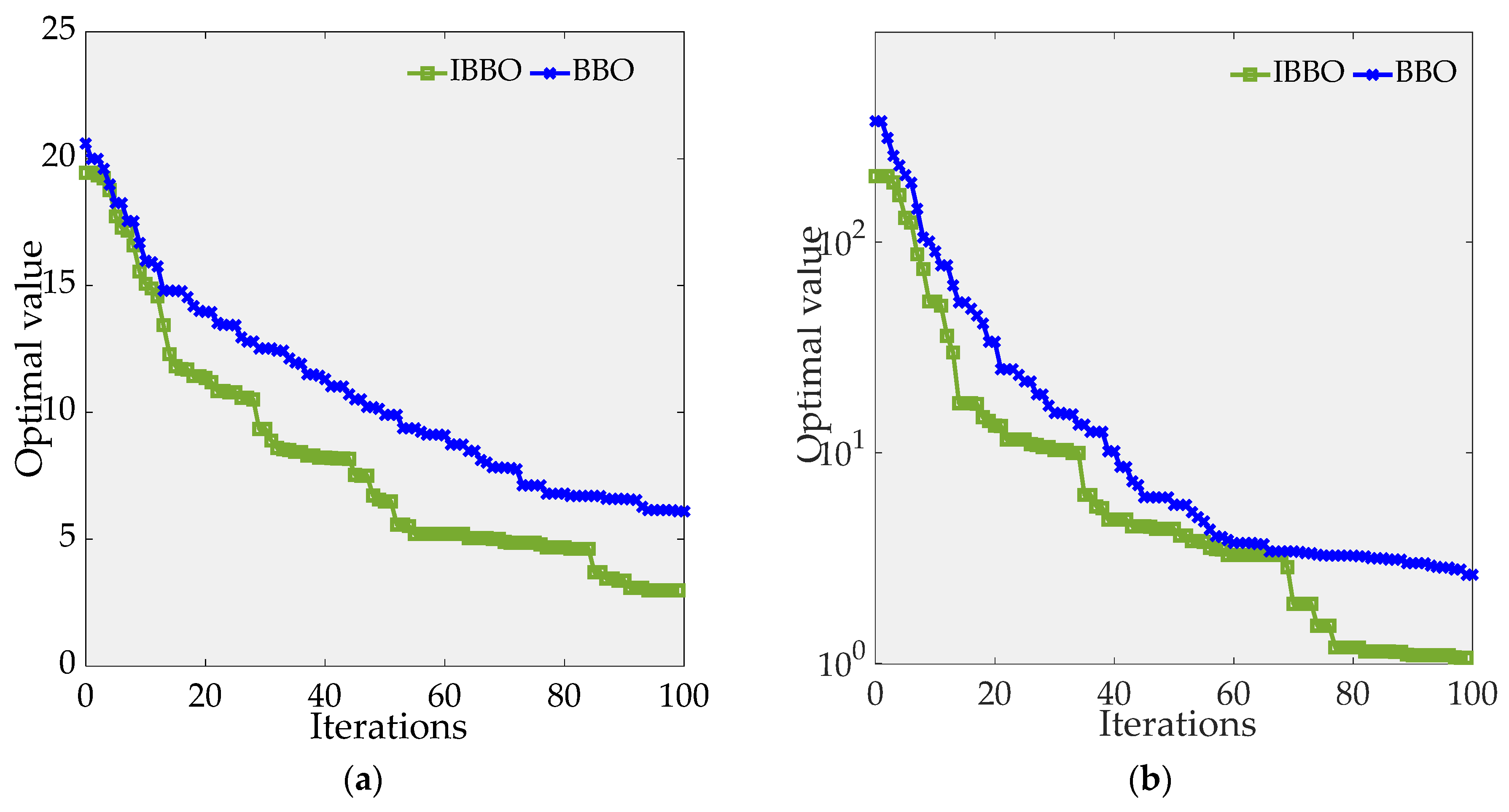

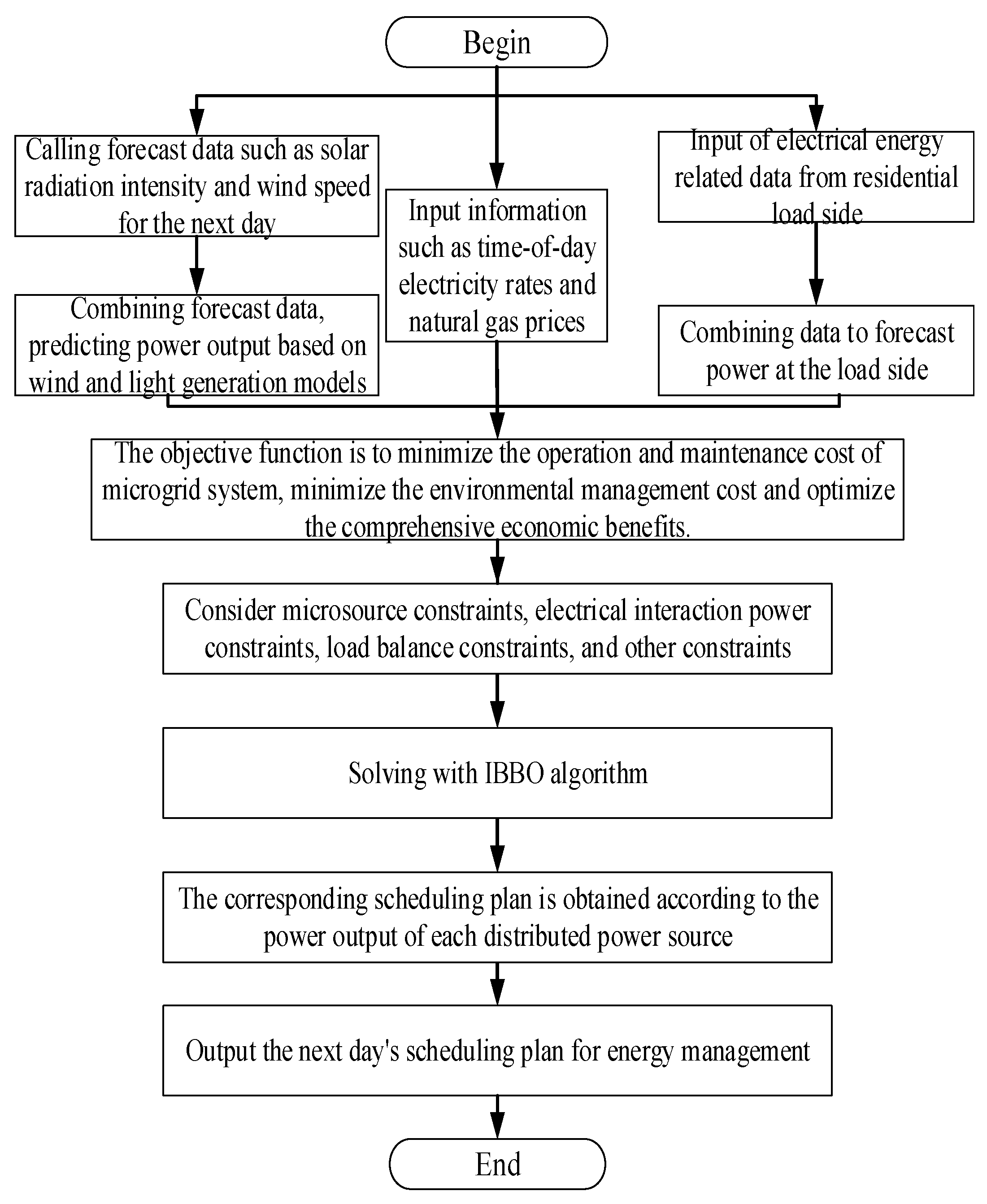



| Polluting Gases | WT (g/(kWh)) | PV (g/(kWh)) | MT (g/(kWh)) | DE (g/(kWh)) | Governance Costs (Yuan/kg) |
|---|---|---|---|---|---|
| CO2 | 0 | 0 | 729.6 | 1185 | 0.025 |
| SO2 | 0 | 0 | 3.36 | 115.3 | 6.5 |
| NOX | 0 | 0 | 1.56 | 76.74 | 8.0 |
| Function | Expression | Space | Dimension |
|---|---|---|---|
| (Ackley) | 30 | ||
| (Griewank) | 30 | ||
| (Rastrigin) | 30 | ||
| (Rosenbrock) | 30 | ||
| (Schewefel2.21) | 30 | ||
| (Step) | 30 |
| Function | Algorithm | Avg | OV | Std | Mode |
|---|---|---|---|---|---|
| BBO | 1.07 × 101 | 6.12 × 100 | 3.88 × 100 | 6.75 × 100 | |
| IBBO | 8.04 × 100 | 2.97 × 100 | 4.51 × 100 | 5.21 × 100 | |
| BBO | 3.46 × 101 | 2.63 × 100 | 7.38 × 101 | 3.94 × 100 | |
| IBBO | 2.05 × 101 | 1.06 × 100 | 4.59 × 101 | 3.26 × 100 | |
| BBO | 4.42 × 101 | 1.49 × 101 | 5.88 × 101 | 1.77 × 101 | |
| IBBO | 2.51 × 101 | 0 | 5.03 × 101 | 0 | |
| BBO | 2.70 × 102 | 9.64 × 101 | 5.85 × 102 | 1.12 × 102 | |
| IBBO | 1.64 × 102 | 2.19 × 101 | 4.20 × 102 | 2.19 × 101 | |
| BBO | 1.03 × 101 | 5.83 × 10−1 | 2.34 × 101 | 8.83 × 10−1 | |
| IBBO | 6.91 × 100 | 0 | 1.47 × 101 | 0 | |
| BBO | 3.48 × 103 | 1.55 × 102 | 7.12 × 103 | 1.55 × 102 | |
| IBBO | 2.26 × 103 | 7.63 × 101 | 4.84 × 103 | 7.57 × 102 |
| Power Supply | Output Power (kW) | Rated Power (kW) | Coefficient | Maintenance Costs (Yuan/kWh) | Service Life (Year) |
|---|---|---|---|---|---|
| WT | 0–480 | 500 | 0.2098 | 0.12 | 10 |
| PV | 0–480 | 500 | 0.0092 | 0.08 | 20 |
| MT | 0–1000 | 1000 | 0.0473 | 0.06 | 15 |
| DE | 0–800 | 800 | 0.0836 | 0.04 | 15 |
| Objective Functions | System Operating Cost (Yuan) | Environmental Governance Cost (Yuan) | Total Cost (Yuan) |
|---|---|---|---|
| Lowest system operating cost | 1432.1 | 1387.3 | 2819.4 |
| Lowest environmental governance cost | 1899.7 | 620.4 | 2520.1 |
| Optimal comprehensive economic benefits | 1747.9 | 632.9 | 2380.8 |
Publisher’s Note: MDPI stays neutral with regard to jurisdictional claims in published maps and institutional affiliations. |
© 2022 by the authors. Licensee MDPI, Basel, Switzerland. This article is an open access article distributed under the terms and conditions of the Creative Commons Attribution (CC BY) license (https://creativecommons.org/licenses/by/4.0/).
Share and Cite
Zhang, Q.; Wei, L.; Yang, B. Research on Improved BBO Algorithm and Its Application in Optimal Scheduling of Micro-Grid. Mathematics 2022, 10, 2998. https://doi.org/10.3390/math10162998
Zhang Q, Wei L, Yang B. Research on Improved BBO Algorithm and Its Application in Optimal Scheduling of Micro-Grid. Mathematics. 2022; 10(16):2998. https://doi.org/10.3390/math10162998
Chicago/Turabian StyleZhang, Qian, Lisheng Wei, and Benben Yang. 2022. "Research on Improved BBO Algorithm and Its Application in Optimal Scheduling of Micro-Grid" Mathematics 10, no. 16: 2998. https://doi.org/10.3390/math10162998
APA StyleZhang, Q., Wei, L., & Yang, B. (2022). Research on Improved BBO Algorithm and Its Application in Optimal Scheduling of Micro-Grid. Mathematics, 10(16), 2998. https://doi.org/10.3390/math10162998






